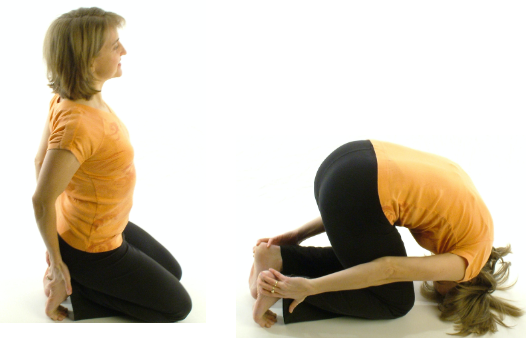Primary Objective of the Ásana
The hare posture relieves tension in the spine. Shasháungásana may improve memory and meditation. It affects the entire body, including all glands and plexi.
Repetitions (standard): 8
Length of hold (ideal): 8 seconds
Breath: exhale kumbhaka

| Steps of practice | Further details & rationale |
| 1.- The knees can be together or hip-width apart. – Keep the toes tucked under, facing forward. – Open the heart center and lengthen the torso with a deep inhale. | – The chin may be lowered toward the chest at the beginning of the pose. |
| 2. – As you exhale, slowly lean forward rounding the back and gently place the crown of the head evenly on the mat.Press the crown or hairline gently into the floor. -Slide the hands down the outside of the legs. – Raise the hips away from the heels and towards the sky, while rounding the upper spine. -Grasp the ankles. – After exhaling, hold your breath for 8 seconds. | – The head may be a little bit away from the knees. -Do not press all of your weight onto the head. – Feel free to use a strap if you have problems holding the heels with your hands. – Imagine that you are trying to lift your spine to the sky. |
| 3. – On the next inhale breath, slowly come back to an upright position. – On the next exhale, bend down into the posture again. After exhaling, hold your breath for 8 seconds. – Repeat up to 8 times. | – If necessary, one may take a breath between repetitions (especially in a class setting) and on the following exhalation bend forward into the posture again. |
| 4. – After 8 repetitions, rest in Vajrásana/Thunder, Balásana/Child’s pose, or Shavásana for a few breaths to integrate the effects of the posture and let the body recover. | |
Main Muscles Involved & Anatomical Movements
- Erector Spinae, quadratus lumborum, quadricep femoris.
- Tibialis anterior, ankle dorsiflexion.
Preparatory Steps
- Simple squats, knee bends, or knee circles.
Considerations
Safety essentials
- Try not to press all of your weight onto the head by grabbing the heels and regulating the amount of weight that comes into the head.
- Be careful to not hyperflex the neck, but let the rounding take place in the thoracic spine and lumbar.
Common misalignments
- Keeping the hips near the heels. Hips are raised away from heels.
- Placing too much pressure on the crown, compressing the neck.
Modifications
- One can come down on the forehead and roll up to the crown of the head.
- If you have problems holding the heels with your hands, you can use a strap or hold the calves.
- If you have ankle problems, you can relax the top of the feet on the mat.
- If you have difficulty rising from the ground, you can place one hand on either side of the knees, palms down, and push yourself up.
Kneeling Yoga Mudrá Shasháunga
- Interlacing fingers behind the back, coming down onto the crown of the head.
Half Headstand Shasháunga
- Perform Kneeling Yoga Mudrá. When you are bent downwards and with your head on the ground, lift the feet off the ground. Knees remain on the floor. Hands may hold the calves up or be placed on the ground for stability. Contraindicated in the case of knee problems.
Contraindications
- High blood pressure, cervical or other vertebral stress.
- Knee problems. Pregnancy.
Benefits
- Can relieve hemorrhoid symptoms.
- Benefits the veins and nerves of the back.
- Helps to balance hormonal secretions.
- Nourishes the nervous system.
- Massages the brain.
- Can strengthen the digestive system.
- May diminish symptoms of insomnia.
- May heighten memory and concentration abilities.
- Can assist in relieving sinus problems.
- Helps to minimize restless leg symptoms.
- Improves sadhana.
- If for some reason you cannot practice Shoulderstand, this is a nice alternative pose.
Visualizations & Ideations
- I leave the results of my actions at the feet of the Divine One
- I leave my ego at the feet of the Supreme.
- The Supreme is within and without and in all places.
- The Divine One is seated in my heart.
- Remove the sands of mind and you will find the clear, cool waters of the Divine within.
- I attune to the eyes and ears of my cosmic Inner Landscape.s
Chakras
- Fortifies all chakras (especially the top 3).
Glands
- Reproductive glands. Adrenals. Pancreas. Thymus. (Lymph nodes.) All glands.
Companion and Compensatory Ásanas
Companion: The traditional ‘high kneeling Ushtrásana can be alternated with a high kneel backbend, touching the heel with one hand and pointing the other hand towards the sky.
Compensatory: Bhújaungásana/Cobra.